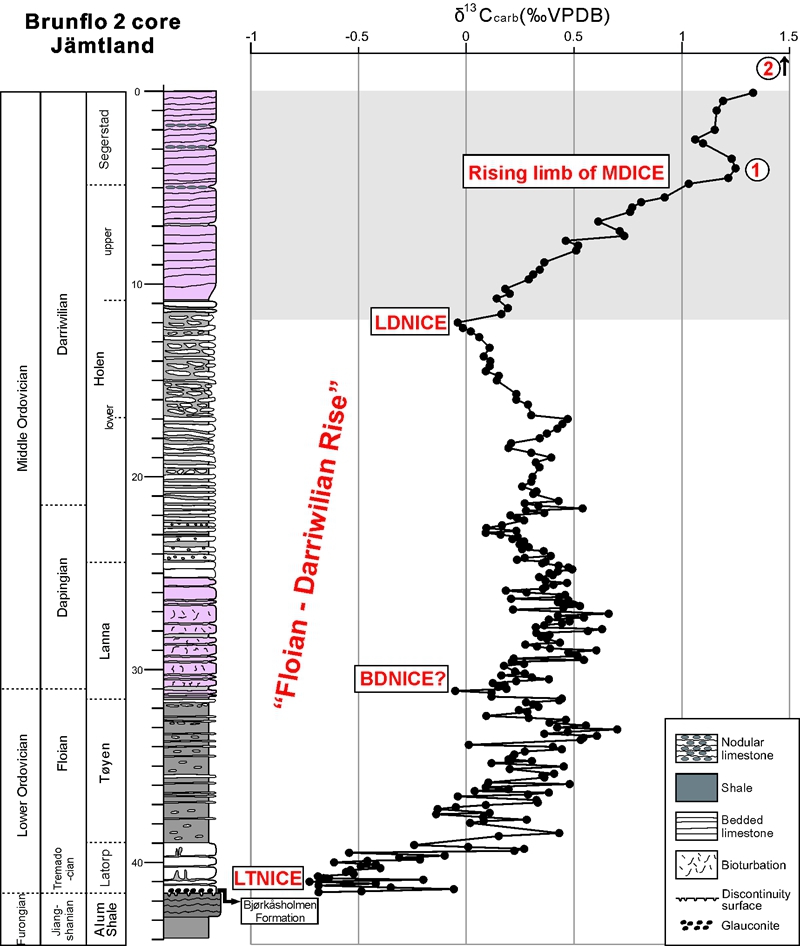Carbon isotope chemostratigraphy has proved to be an efficient tool for refining the temporal correlation of ancient sedimentary successions. For the Ordovician period, numerous studies have been carried out over the last years, resulting in recognition of a series of distinct anomalies in the carbon isotope record. These ‘excursions’ form the basis for regional and global correlation of sedimentary packages that may be only a few metres thick or even less. Up to now, only one positive δ13C excursion has been formally named from this time interval, i.e., the Middle Darriwilian Isotope Carbon Excursion.
Recently, Dr. WU Rongchang from Nanjing Institute of Geology and Palaeontology, Chinese Academy of Sciences and colleagues from Lund university (Sweden) and University of Erlangen-Nürnberg (Germany) have carried out carbon isotope analysis of the Lower through Middle Ordovician cool-water carbonates of the Brunflo 2 core from near Brunflo in the J?mtland province of west-central Sweden. The studied succession is 41.55 m thick and includes, in ascending order, the Bj?rk?sholmen Formation, Latorp Limestone, T?yen Shale, and the Lanna, Holen,and Segerstad limestones. The result shows that two distinct positive δ13C excursions that can be used for intra- as well as inter-continental correlations. A positive excursion in the T?yen Shale probably correlates to the mid-late Floian and the Oepikodus evae Zone in Baltica and Precordillera, and the Reutterodus andinus Zone in North America. A continuous increase in δ13C values through the upper Holen Limestone and the preserved part of the overlying Segerstad Limestone is interpreted as the rising limb of the Middle Darriwilian Isotope Carbon Excursion (MDICE), an important tie-point for the global correlation of the J?mtland strata.
This study is supported by the National Natural Science Foundation of China, the Swedish Research Council and Crafoord Foundation and the Deutsche Forschungsgemeinschaft.
Related information of this paper: Wu, R.C., Calner, M., Lehnert, O., Perterffy, O. & Joachimski, M.M., 2015. Lower–Middle Ordovician 13C chemostratigraphy of western Baltica (J?mtland, Sweden). Palaeoworld 24, 110–122. doi:10.1016/j.palwor.2015.01.003

Carbon isotope chemostratigraphy in the Brunflo 2 core from J?mtland, Sweden showing the levels of identified δ13C events: LTNICE (Late Tremadocian Negative Isotopic Carbon Excursion), LDNICE (Lower Darriwilian Negative Isotopic Carbon Excursion), and the rising limb of the MDICE (Middle Darriwilian Isotopic Carbon Excursion). There are many fluctuations in the Floian and Dapingian δ13C record; the assumed position of the BDNICE (Basal Dapingian Negative Isotopic Carbon Excursion) is placed in the lower Lanna Limestone where generally slightly lower values are observed.
Download:
